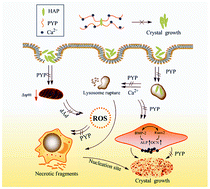Seaweed Porphyra yezoensis polysaccharides with different molecular weights inhibit hydroxyapatite damage and osteoblast differentiation of A7R5 cells
Abstract
Vascular calcification (VC) is a common pathological manifestation in patients with cardiovascular diseases, leading to high mortality in patients with chronic kidney diseases. The deposition of hydroxyapatite (HAP) crystals on vascular smooth muscle cells leads to cell damage, which promotes osteogenic transformation. In this study, four different molecular weights (MWs ) of Porphyra yezoensis polysaccharides (PYP1, PYP2, PYP3, and PYP4 with MWs of 576, 49.5, 12.6, and 4.02 kDa, respectively) were used to coat HAP, and the differences in toxicity and calcification of HAP on A7R5 cells before and after coating were studied. The results showed that PYPs could effectively reduce HAP damage to the A7R5 cells. Under the protection of PYPs, cell viability increased and lactate dehydrogenase release, active oxygen level, and cell necrosis rate decreased; also, the amount of the HAP crystals adhering to cell surfaces and entering cells decreased. PYPs with low molecular weights presented better protective effects than high-molecular-weight PYPs. PYPs also inhibited the osteogenic transformation of the A7R5 cells induced by HAP and decreased alkaline phosphatase (ALP) activity and expressions of bone/chondrocyte phenotype genes (runt-related factor 2, ALP, osteopontin, and osteocalcin). In the adenine-induced chronic renal failure (CRF) mouse VC model, PYP4 was found to obviously inhibit the aortic calcium level, and it also inhibited the serum creatinine, serum phosphorus and serum BUN levels. PYP4 (least molecular weight) showed the best inhibitory effect on calcification and may be considered as a candidate drug with therapeutic potential for inhibiting cellular damage and osteoblast differentiation induced by the HAP crystals.



 Please wait while we load your content...
Please wait while we load your content...